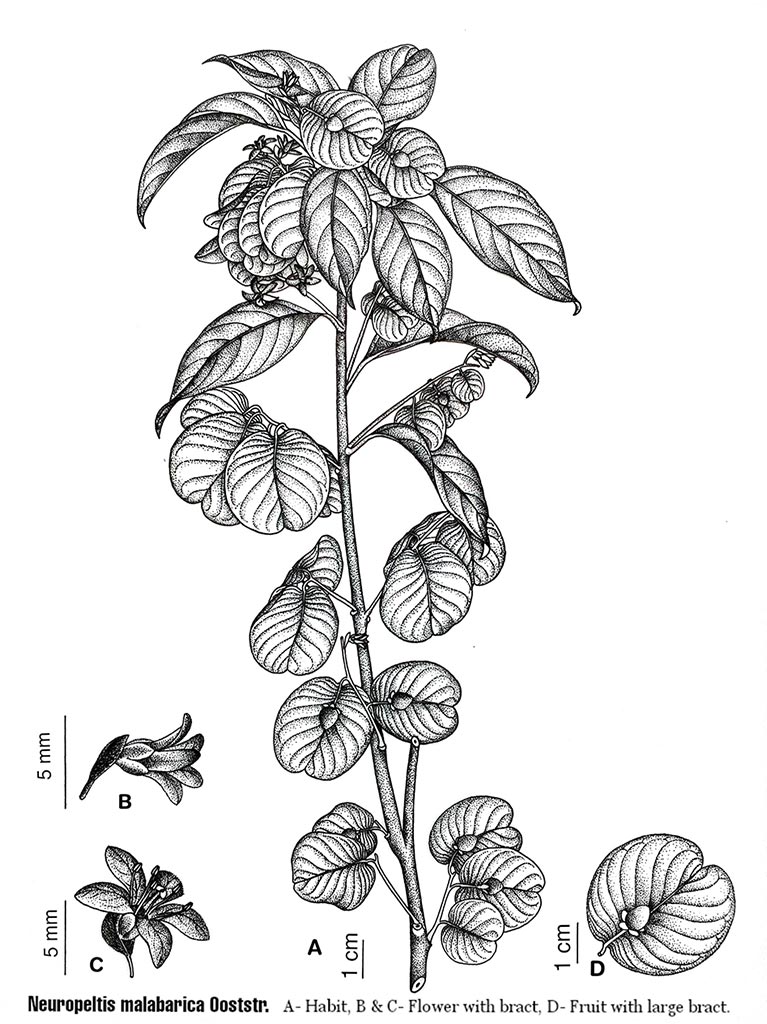
Text and Illustration: Drisya V. V.
Scientific Name: Neuropeltis malabarica Ooststr.
Family: Convolvulaceae
Malayalam Name: Pattilavalli
Location of the plant: Madayippara
Endemism: Endemic to southern western ghats (Kerala).
Habit: Woody climber
Description: Large woody climbers; stem lenticellate; young branches brown tomentose, terete, later glabrous with warty tubercles. Leaves simple, alternate, elliptic or oblong 5-12 x 2-5 cm, margins entire, base acute to obtuse, apex shortly caudate acuminate, young leaves densely tomentose above, becoming glabrous when mature, lateral nerves 8-10 pairs, intercostae reticulate; petiole c. 1cm long, initially densely tomentose ultimately glabrous. Flowers in axillary racemes, peduncle densely brown tomentose, 4-9 cm long; pedicel brief to 5 mm long, bracteate; bracts small, c. 5 mm long, both sides densely tomentose in flower, base adnate to pedicel slightly below the calyx, enlarged and broadly elliptical c. 2-3 cm in fruits; sepals 5, c. 2.5 mm long, broadly ovate, densely brown tomentose outside; petals 5, c. 5 mm long, campanulate, white, densely brown tomentose outside, glabrous inside, ovate elliptic, tube 1.5 mm long, lobes 4 x 2 mm; stamens 5, c. 3 mm long, filaments white, basifixed, epipetalous, anther oblong; ovary subglobose, c. 1.5 mm, densely pilose. Style 2, filiform, c. 2.5 mm long, separate from the base, stigmas large, globose. Fruit capsule, globose, c. 5 mm long, sessile or shortly stalked in the middle of the flat enlarged bract, bracts long 2.5 – 3.5 cm across, membranous, reticulately veined. Seeds ovoid, glabrous.
Flowering and fruiting: November – March
Distribution: Endemic to the Southern Western ghats (Kerala). Very rare; in the margins of scrub jungles. No of the plants is very less, it only reported from the four districts of Kerala (Thrissur, Ernakulam, Kozhikode, Kannur).
Interesting feature: During the time of dispersal these plant fruits show a distinct flight behavior in the air with the help of their well-developed bracts. These bracts are small, c. 5 mm long, densely tomentose, and minutely mucronate in flower, that developed into a 3- 3.5 cm long broadly elliptical and membranous wing in fruit. These large bracts in fruit act as wings and help to fly in the air for their dispersal.
Citation: Neuropeltis malabarica Ooststr., Blumea 5: 272. 1942; Sasidh., Biod. Doc. Kerala 6, Fl. Pl. 312. 2004. Neuropeltis racemosa sensu Bedd., Ic. t. 291. 1868; Hook. f., Fl. Brit. India 4: 225. 1883, p. p.; Gamble, Fl. Madras 922. 1923, non wall. 1824.
